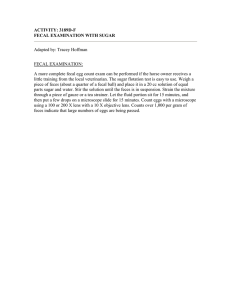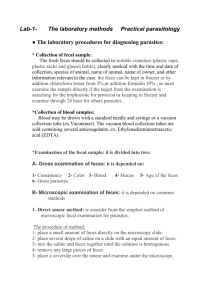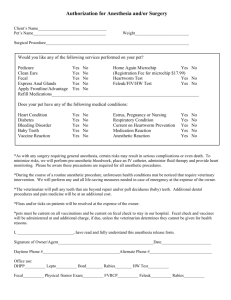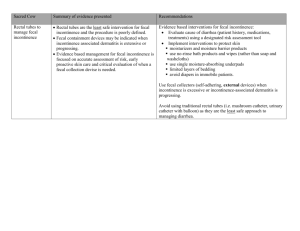Powerpoint
advertisement
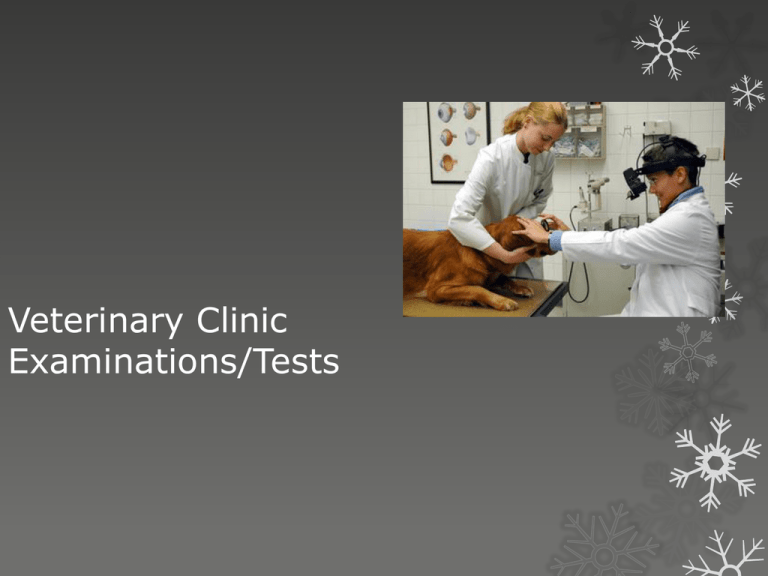
Veterinary Clinic Examinations/Tests Next Generation Science/Common Core Standards Addressed! CCSS.ELA-Literacy.RH.11-12.1 Cite specific textual evidence to support analysis of primary and secondary sources, connecting insights gained from specific details to an understanding of the text as a whole. CCSS.ELA-Literacy.RH.11-12.9 Integrate information from diverse sources, both primary and secondary, into a coherent understanding of an idea or event, noting discrepancies among sources. Bell Work! Explain the function of the animals white and red blood cells. Explain how you would prevent blood from coagulating after it has bee drawn from an animal. What would be the result of drawing blood from and animal too rapidly. Terms! Acetone Acidity Albumin Alkalinity Bile Bilirubin Calcium Advantages of Fecal Exams Fecal exam is commonly used to look for parasitic diseases. Parasitic diseases in animals need to be controlled because they may result in: Reduced production of meat and milk Slow growth rates Cause infertility and abortions Death of the animal in severe cases Fecal Examinations Cont. Examining fecal samples is a very common practice in all veterinary clinics. Exams may result in the identification of worm eggs and larvae as well as cysts. The three most common tests area; Smear Flotation Gross examination Fecal Examinations Cont. Fecal Collection – Always secure a fresh sample, making sure that it is from the patient in question. Make sure that the sample has not been contaminated by foreign material ( grass, rocks, straw). If the exam will be delayed make sure that the sample is stored in an air tight container and placed in a refrigerator. Direct Smear Fecal Examination The direct smear fecal examination may be the least accurate method of fecal examination. A small amount of feces is mixed with saline solution or water and placed on a microscope slide. The sample is observed under low power. Observe the mixture on the slide for larvae and worm eggs. Flotation Fecal Examination Fecal Flotation Exams ae more complicated and time consuming than a direct smear. A flotation solution using sugar or salt is added to the feces, mixed thoroughly and then filtered through gauze. The solution is placed in a tube and centrifuged for three minutes. Place a drop from the top of the tube on a slide for examination. Fecal material should have settled to the bottom of the tube while eggs/larvae floated to the top of the solution. Gross Examination of Fecal material. A gross examination is nothing more than a visual observation of the animals feces. Look at the color of the feces Is there mucous present Is there blood present Is undigested food present Are parasites observed Blood Examinations Many diseases may be diagnosed with the use of a blood sample. Blood consists of the following materials; Red blood cells – erythrocytes White blood cells – leukocytes Platelets – thrombocytes Plasma – light fluid that suspends cells Blood Collection In a veterinary clinic, blood from patients is generally collected from a prominent vein. Very light suction is used on the syringe, the blood should flow into the syringe. Excessive pressure will destroy the red blood cells. When blood is collected it is mixed with an anti-coagulant to prevent clotting. Blood Tests Blood that is going to be used for a smear test should utilized within 10-15 minutes of collection. Blood that will be used for other types of tests should be used within 24 hours. Blood is always stored in refrigerators. Common Blood Tests Blood Smears – One drop of blood collected from the sample with a pipette is evaluated under a microscope. Hemoglobin Tests – Hemoglobin tests are conducted using a colorimeter which will compare the sample with a color standard. Blood Cell Counts – This particular test will count the number of erythrocyte and leukocyte cells per volume of blood in the sample. Urine Examination Urine samples are collected by various methods. Samples must be collected in a clean, dry container. Collection catheters, stimulation and collection urinal may be used. Small animals may be collected by applying pressure to the bladder or by using a collection cage. Urine Examination Physical examination of an animals urine sample would include; The odor The color The consistency The volume Urine Examination The consistency of urine color is measured in degrees of color; clear cloudy flocculant opaque Urine Tests A laboratory test of the urine sample could yield the following information. pH Sugar Bile Acetone Calcium Bilirubin Albumin Bacteriologic Tests Simple bacteriologic tests may be completed at the local clinic or samples may be submitted to diagnostic labs. Bacteriologic Tests There are four basic methods of bacteriologic testing/ diagnosis procedures; Culture Serologic tests Animal inoculation Direct microscope exam The End!
